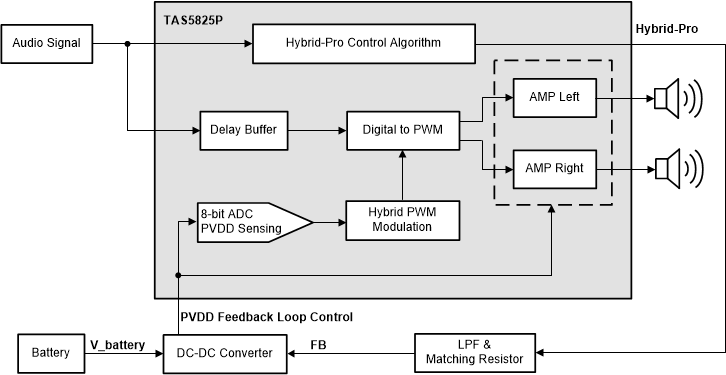ZHCSKF7A May 2019 – January 2023 TAS5825P
PRODUCTION DATA
- 1 特性
- 2 应用
- 3 说明
- 4 Revision History
- 5 Device Comparison Table
- 6 Pin Configuration and Functions
- 7 Specifications
- 8 Parameter Measurement Information
-
9 Detailed Description
- 9.1 Overview
- 9.2 Functional Block Diagram
- 9.3 Feature Description
- 9.4 Device Functional Modes
- 9.5 Programming and Control
- 9.6 Register Maps
-
10Application and Implementation
- 10.1 Application Information
- 10.2 Typical Applications
- 10.3 Power Supply Recommendations
- 10.4 Layout
- 11Device and Documentation Support
- 12Mechanical, Packaging, and Orderable Information
3 说明
TAS5825P 是一款采用先进 Hybrid-Pro 算法的立体声高效闭环音频 D 类音频放大器,可提高系统效率并减少发热而不会产生削波失真。
音频放大器的电源电压 (PVDD) 通常由直流/直流转换器提供。与固定 PVDD 相比,基于音频信号而波动的可变 PVDD 可显著提高效率,降低空闲电流并减少发热。
TAS5825P 的强大音频 DSP 内核实现了一种称为 Hybrid-Pro 的专有算法。Hybrid-Pro 算法可检测即将发生的音频功率需求,并通过 Hybrid-Pro 反馈引脚 (HPFB) 为前直流/直流转换器提供 PWM 控制信号。TAS5825P 支持高达 4ms 的延迟缓冲器,以提前查看音频信号并防止音频削波失真。在各种实验中,TAS5825P 在连续播放音乐时可将 1S 和 2S 电池的运行时间延长 50% 以上。
器件信息(1)
| 器件型号 | 封装 | 封装尺寸(标称值) |
|---|---|---|
| TAS5825P | VQFN (32) RHB | 5.00mm × 5.00mm |
(1) 如需了解所有可用封装,请参阅数据表末尾的可订购产品附录。
